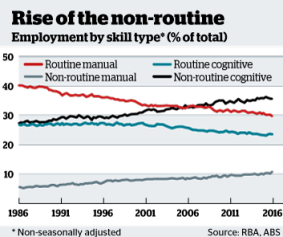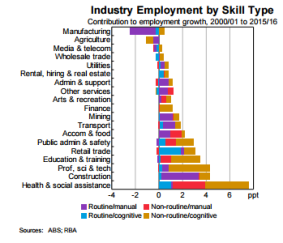By Jessica Irvine
What do you want to be when you grow up?
It's a question we ask too often of children – who legitimately should have no idea – and not nearly enough of adults.
Australians are working longer than ever before, but the idea of a job for life is dead. The typical worker will now have several jobs in their lifetime and the nature of those jobs is constantly evolving.
On the surface, our economy appears to be in a process of slowly sanitising itself. Grimy jobs in manufacturing and agriculture have been lost, replaced by an army of professional services workers toiling in gleaming skyscrapers.

You can still wear a hardhat in the workplace of the future, but you will need to perform non-routine tasks to survive, a new Reserve Bank analysis has found.
Aussie kids, we are told, no longer want to get their hands dirty, aspiring instead to a slick suit and a corner office.
But the reality of our changing workforce, as revealed in a speech last week by the Reserve Bank's head of economic analysis, Alexandra Heath, is more complex than that.
And anyone concerned with having a job in five, or 10, years would do well to pay attention.
According to Heath, the Australian workforce can be split up into four distinct categories: routine manual, routine cognitive, non-routine manual and non-routine cognitive.

Most would be aware of the division between manual and cognitive labour, those toiling with their hands, and those with their minds.
But the workforce can also be divided along another important line: those doing routine jobs – according to a set pattern – and those performing non-routine functions, requiring problem-solving skills and out-of-the-box thinking.

Head of economic analysis at the Reserve Bank of Australia, Alexandra Heath.
You might think the first division, between manual and cognitive, has been the most profound change over the past few decades.
But it turns out this second distinction, between the routine and non-routine tasks, is the real driver of the changing jobs landscape.

Among jobs considered non-routine and cognitive, the fastest growing by far have been in healthcare.
This categorisation of the workforce is not new, coined by MIT economist David Autor and colleagues in 2003.
But under the direction of Heath, researchers at the Reserve Bank have combed through our labour force data to breakdown the Australian workforce into the four groups.
The researchers took data for 17 industries and the eight major occupations within each and classified each jobs into one of the four groups.
What they found was clear.
As expected, the sharpest decline was in the share of jobs that could be considered "routine manual". A good example of such would be forklift drivers. More sophisticated machinery and assembly lines have made many of these workers redundant. In the mid 1980s, such jobs made up the biggest group of workers, accounting for four out of 10 jobs. Today that has fallen to three in 10.
Today the biggest employing category is that of "non-routine cognitive" jobs, representing about one in three jobs, up from one in four. A good example of these jobs would include journalists, economists and architects. We can't lift a sack of potatoes, but we must continually think in new ways.
So, is the main problem of the fork-lift drivers that they employed their hands, not their minds? Or that the job they did was predictable in nature, and therefore easily automated?
Turns out, it was the latter. Workers toiling in jobs that can be easily routinised, be they manual or non-manual jobs, are the most vulnerable.
It's obvious that much manual labour can be replaced by machines. But a lot of non-manual, or cognitive, work can be replaced too, if not by machines then by foreigners. Just think of the last time you rang your phone company. No doubt the first part of your conversation was with a machine and then a lovely chap in Mumbai. Such calls invariably follow a script, with operators working their way through an obvious problem-solving tree.
Just as routine manual jobs have shrunk, so too have these routine but cognitive jobs, such as call centre operators.
So if you want a job where you don't use your hands, you'd better be prepared and able to use your mind in less-predictable ways.
And there's no reason for snobbery when it comes to using your hands. While routine manual jobs have been shrinking, non-routine manual jobs have been expanding. Waiters and waitresses use their hands, but can't easily be replaced by robots. Many jobs in the expanding sectors of healthcare and aged care, too, require strong arms but the uniquely human touch. Childcare workers, too, fall into this category.
So, if you really want a job of the future, you should still be prepared to break a sweat.
But the one thing you mustn't become is predictable.
"The increase in the relative importance of non-routine jobs suggests that people will need skills that are not easily replicated by technology, such as social intelligence, creativity and complex manual dexterity," concludes Heath.
Furthermore, "learning how to learn, developing problem solving skills and having 'core' skills in maths or science" will be critical skills we must all learn if we are to survive in the new jobs landscape.